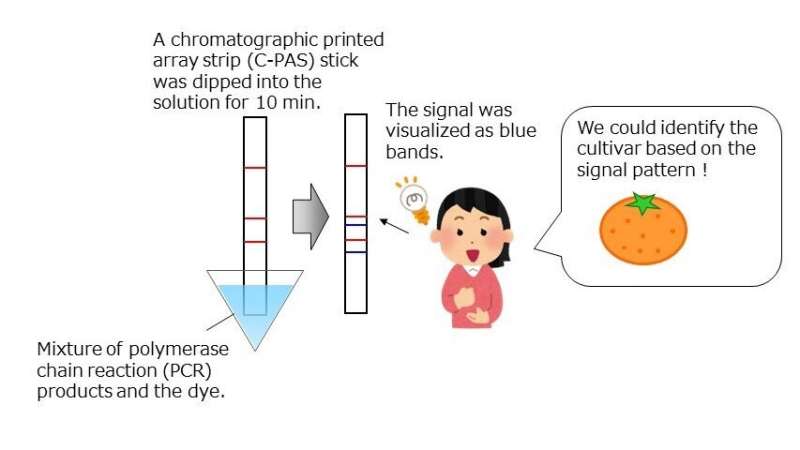This article has been reviewed according to Science X's editorial process and policies. Editors have highlighted the following attributes while ensuring the content's credibility:
fact-checked
trusted source
proofread
A novel solution to safeguard Japan's unique citrus cultivars and their breeders' rights

Citrus cultivation holds significant importance in Japan and has recently attracted both domestic and global attention. With an agricultural production value of approximately 201 billion yen, citrus is the third most important agricultural product in Japan.
The success of the Japanese citrus industry is attributed to the development of new cultivars that are free of pests and diseases, climate-resilient, and exhibit superior fruit quality. Notable examples include "Asumi," "Asuki," "Ehimekashidai28go," "Ehimekashidai48go," "Himekoharu," "Kanpei," "Rinoka," and "Mihaya," all of which display improved agricultural traits such as higher sugar content, resistance to diseases like citrus canker, and a reduced tendency to drip when cut.
There has, however, been a growing concern over the infringement and violation of breeding rights of citrus cultivars developed in Japan. This issue stems from their unauthorized export and cultivation overseas, followed by the importation of infringing fruit back into the country. This practice results in a loss of business in overseas markets, infringing the rights and severely jeopardizing the livelihoods of Japanese farmers.
So, in 2021, the Japanese government revised the Plant Variety Protection and Seed Act to prevent overseas outflow of registered cultivars, safeguarding the rights of citrus breeders. Moreover, researchers developed cultivar-specific DNA identification systems such as cleaved amplified polymorphic site (CAPS) markers and TaqMan-MGB single-nucleotide polymorphism (SNP) genotyping assays, which could discriminate the target registered cultivar from others.
However, these identification methods are time consuming and there is a growing need for faster and more user-friendly systems that can effectively identify Japanese cultivars, particularly at on-field inspection sites, so that the import of counterfeit fruit is curbed.
To this end, a group of Japanese researchers led by Associate Professor Yuki Monden from Okayama University and Mitsutoshi Okamoto of Ehime Research Institute of Citrus Fruits—and also comprising Takehiko Shimada of the National Agriculture and Food Research Organization, and Kazuto Takasaki and Tomoyuki Takeuchi of FASMAC Co. Ltd.—developed a new DNA marker-based cultivar identification system for eight prominent Japanese citrus cultivars. A paper detailing their study was published in Breeding Science.
Speaking on their novel breakthrough, Prof. Monden says, "This system accurately identifies citrus cultivars by detecting DNA polymorphisms—fragments of DNA that are unique to each of the target cultivars." The study employed genetic sequencing techniques to identify three retrotransposon families (CIRE1, Tcs1, and Tcs2) that are transcriptionally active in citrus plants. Retrotransposons are genetic elements that exhibit high copy numbers which can be used to detect cultivar-specific DNA polymorphisms.
By analyzing their insertion sites through sequencing, unique DNA markers for specific cultivars were identified. These cultivar-identifying DNA markers comprising of polymorphic InDel (insertion-deletion) fragments in combination with a polymerase chain reaction (PCR)-positive marker for the ribulose-1,5-bisphosphate carboxylase/oxygenase (rbcL) gene were successfully detected within 15 minutes using a small membrane stick, the chromatographic printed array strip (C-Pas).
This straightforward process can be accomplished within one hour of DNA extraction and can clearly determine whether the tested fruit sample belongs to a registered cultivar. The developed system thus offers significant advantages as a convenient, rapid, and cost-effective DNA diagnostic method to inspect fruit imports. The proposed target cultivar-specific identification system is anticipated to function as an efficient tool for promptly identifying and acting against suspicious, unlicensed cultivars.
With time, Professor Monden hopes that this identification method can help strengthen the expansion of Japanese exports.
"At present, the Japanese government is actively promoting the expansion of exports in the agricultural, forestry, fishery, and food sectors, with targets of achieving a 2-trillion-yen export value by 2025, which would expand to 5 trillion yen by 2030. While these efforts to boost exports are being strengthened, there is a growing concern regarding the piracy of excellent cultivars bred in Japan," she says.
She hopes their revolutionary work can enhance the competitiveness of Japanese cultivars by protecting the rights of breeders who breed them, eventually.
More information: Mitsutoshi Okamoto et al, A target cultivar-specific identification system based on the chromatographic printed array strip method for eight prominent Japanese citrus cultivars, Breeding Science (2023). DOI: 10.1270/jsbbs.22065
Provided by Okayama University




















